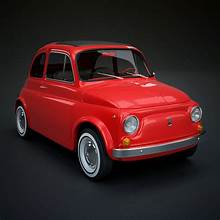In the annals of automotive history, few vehicles can claim the enduring charm and cultural significance of the original Fiat 500. Launched in 1957, this diminutive car captured the hearts of millions with its adorable design, practicality, and affordability. Despite its small stature, the car, often referred to simply as the “Cinquecento,” became a symbol of Italy’s post-war recovery and a beloved icon of automotive design.
A Little Car with Big Ambitions
In the aftermath of World War II, Europe was in dire need of affordable transportation solutions. Fiat, one of Italy’s leading automotive manufacturers, rose to the occasion with the introduction of the Fiat 500. Designed by Dante Giacosa, the 500 was a marvel of engineering, packing impressive features into its compact frame. With seating for four occupants (albeit cozy ones), a canvas roof that rolled back like a sardine can, and a rear-mounted 479cc two-cylinder engine, the Fiat 500 was the epitome of practicality.
Fiat 500; Cultural Phenomenon
The Fiat 500 quickly transcended its status as a mere mode of transportation to become a cultural phenomenon. Its quirky design and friendly demeanor endeared it to people from all walks of life. From bustling city streets to picturesque countryside roads, the Fiat 500 became a ubiquitous sight across Italy, symbolizing freedom and individuality.
Its popularity wasn’t limited to Italy alone. The Fiat found admirers far beyond its homeland, becoming a coveted import in markets around the world. Its affordability made it accessible to a wide audience, while its charming aesthetics appealed to the young and the young-at-heart alike.
Fiat 500; An Enduring Legacy
The Fiat 500’s legacy extends far beyond its production years, which spanned from 1957 to 1975. Even after it ceased production, its spirit lived on, kept alive by enthusiasts and collectors who cherished its timeless design and spirited performance. In recent years, Fiat has paid homage to its iconic predecessor with the introduction of the Fiat 500 “Cinquecento” revival.
Reviving a Classic
In 2007, Fiat unveiled the modern interpretation of the car, capturing the essence of the original while infusing it with contemporary technology and amenities. The new Fiat 500 retained the iconic silhouette and playful charm of its ancestor but boasted modern comforts such as air conditioning, power steering, and advanced safety features.
Despite its modern upgrades, the new Fiat 500 stayed true to the spirit of the original. Its compact dimensions and nimble handling made it ideal for navigating crowded city streets, while its fuel-efficient engines appealed to eco-conscious drivers. Like its predecessor, the modern Fiat 500 became a symbol of style and sophistication, earning accolades from automotive enthusiasts and critics alike.
The Fiat Today
Today, the Fiat 500 continues to captivate audiences around the world. Its timeless design has ensured its relevance across generations, appealing to those who appreciate its blend of retro charm and contemporary flair. From bustling urban centers to sun-drenched coastal roads, the Fiat 500 is equally at home navigating city streets as it is cruising along scenic highways.
The Fiat 500 has also embraced the electric revolution, with the introduction of the Fiat 500e. This all-electric version retains the iconic design of its predecessors but swaps out the traditional internal combustion engine for an electric powertrain, offering zero-emission driving without compromising on style or performance.
In an ever-changing automotive landscape, where trends come and go, the Fiat 500 stands as a testament to timeless design and enduring appeal. From its humble beginnings as a post-war economy car to its status as a global icon, the Fiat 500 has left an indelible mark on automotive history.
Whether it’s the original classic or the modern revival, the Fiat 500 continues to bring joy to drivers around the world. Its quirky charm, practicality, and unmistakable style ensure that it remains a beloved symbol of Italian ingenuity and craftsmanship. As we look to the future of transportation, let us not forget the legacy of the Fiat 500—a little car that captured the hearts of millions and left an indelible mark on the automotive world.
